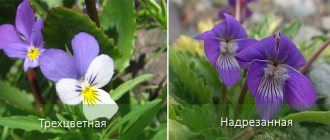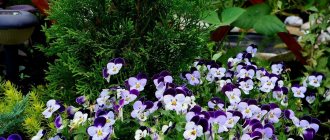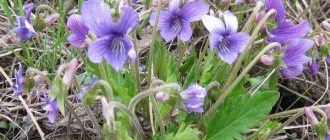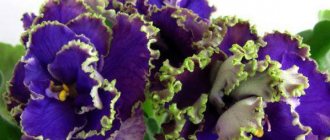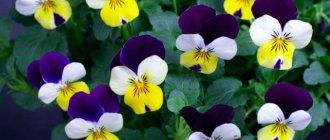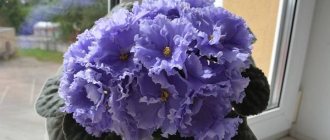Violet, description and photo RS-Dryad (S. Repkina)
Violets from breeders of the CIS countries - “D” (RS).
RS- Dryad (S. Repkina).
RS-Dryad, RS-Driada (S. Repkina).
Very unusual semi-double and double stars of lilac-green color with light fantasy. Fantasy is white, light lilac and light green depending on the color of the background on which it is located. There are no author's descriptions by S. Repkina, so it is useless to look for them; determine your variety or sport yourself. The variety is for everyone.
Dark green flat toothed leaves. Standard. An even rosette on elongated petioles can lift the leaves upward.
Original double and semi-double lilac-swamp flowers with elongated petals in the shape of a bell with light peas. When blooming, the flowers are bright with a distinct light fantasy, but then they lighten up, only the dark “ears” remain bright. Green darkening along the edges of the petals depends on the temperature when the buds are laid and on the age of the rosette.
Violet flowers are somewhat similar to crocus flowers. The violet attracts precisely because of its unusualness; I like the scorch markings, the unbroken coloring, and the shape of the flower. Flower size up to 5 cm.
A long-flowering variety due to the green color of the petals. Flowering lasts up to 2 months, and new flowers are constantly added. There are 3-4 buds on the peduncles. The peduncles are long and fall apart in different directions. Different colors of flowers on different peduncles - for every taste. In hot weather it blooms without any swamp shadows, but when it gets cooler, then they are there.
The variety is very sporty, up to 70%. Sports in different shades of lilac-violet, pink, green and brown with and without polka dots. It is necessary to raise all the children until they bloom. This variety has very large bracts, the flower stalks take root without problems. To get a normal outlet you need to keep it in good and correct light.
RS-Dryad, RS-Palmyra and RS-Wild Forest - these varieties can be combined into a “series”, based on the color and shape of the flower.
Dryads (ancient Greek - tree, in particular oak) - in ancient Greek mythology, forest nymphs, patroness of trees. Sometimes dryads were named after trees. The oldest known nymphs are dryads, born from drops of the blood of Uranus and living in Ash. Dryads are a few of the nymphs who are mortal. It was believed that dryads were inseparable from the tree with which they were connected and died when the tree died. There was a belief that people who plant and care for trees enjoy the special protection of tree nymphs. For damaging or destroying trees, dryads could severely punish a person, for example, deprive him of his mind.
Do you know that…?
Leaves with light yellow spots occur when burned from direct sunlight, leaves with brownish spots - when watered with cold water, pale green with curved edges - when the room temperature is low. Yellowing over the entire surface, especially the lower ones - due to dry air and incorrectly selected soil, size and quality of the pot. Leaves with a colored coating - with systematic flooding.
Before you buy the violets listed below, carefully read the forums about their behavior on the windowsill. Many of them are very beautiful flowers. However, these can be large rosettes with large and fragile leaves, with leaves rising up or hugging the pot, forming many stepsons that interfere with the formation of a neat rosette, pulling the stem up and growing into a Christmas tree, bending the trunk, rare flowering with long breaks, fallen flowers or they last little and quickly wither, very long and recumbent peduncles, the color of the flower fades quickly, they do not like bright lighting on the windowsill, they are afraid of the slightest drying out or waterlogging, a large percentage of them go into sports or darken the flower.
Are they suitable for your window sill and the conditions that you can create for them? You will look at the flowers for several months, and the rosette will always be in front of your eyes. There are many beautiful flowers, there are much fewer beautiful and neat rosettes, look first at the rosette! Search and you may find a dozen violets with the same flower color if you are not interested in the smallest details as a collector.
• — Desdemona (Repkina); • — Demon (Repkina); • — Gin (Repkina); • — Diva (Repkina); • — Wild Forest (Repkina); • — James Bond (Repkina); • — Brownie (Repkina); • — Drakosha (Repkina); • - Dulcinea (Repkina);
Methods of propagation of violet Sea wolf
The best results are obtained by propagating this variety by stepchildren. The mother rosette produces a lot of children, and when transplanting, they are separated with an awl and planted in separate pots. The children have their own root system, so they quickly begin to grow and after 5 months they produce the first flowers.
The variety also propagates well from leaf cuttings. For rooting, take leaves directly under the peduncles. The leaves of the bottom row are too old and therefore not suitable for propagation.
Learn how to properly grow Reigning beauty violets and how to care for them.
We invite you to read a complete review of the violet variety Your Majesty.
Cuttings can be rooted in water. Mixtures of moss and vermiculite and in the soil mixture. When rooting in water, roots 1.5-2 centimeters long are first grown on the cuttings, and then the leaf is placed in the soil mixture. Rooting a violet leaf in water makes it possible to control the process and take timely measures in case of rotting of the cuttings.
Violet variety Sea Wolf is usually propagated by children.
To prevent the cutting from rotting, when placed in water it should not touch the bottom and walls of the dish. You need to add an activated carbon tablet to the water. The depth of immersion of the cutting is no more than 1.5 centimeters. If decay processes have nevertheless begun at the tip, you need to make a fresh cut at an angle of 45 degrees, replace the water, rinse the container and place the leaf in it again.
Peculiarities of propagation by peduncle
A guaranteed way to obtain an exact copy of the mother violet Sea Wolf is propagation by peduncle. The bud, at rest, is located in the axils of the bracts, and after the bud withers, it remains dormant. Rooting the peduncle allows you to obtain this bud for reproduction. The propagation method is absolutely harmless to violets, so you should not neglect it to obtain a new specimen.
For rooting, select a blooming flower with stipules and cut it from the peduncle. A peduncle with an unopened bud is not suitable for rooting, since the formation of a bud has not yet occurred in it. The lower part is cut off, leaving 1 centimeter below the stipules. Root the middle part of the cut peduncle.
The rooting substrate consists of vermiculite, sphagnum moss and peat tablets. The peat tablet is soaked until completely swollen, freed from the mesh, kneaded and mixed with vermiculite and moss.
Rooting the violet peduncle allows you to preserve all the maternal qualities of the variety.
The cut peduncle is placed in the prepared mixture to the level of the leaves. The peduncle planted on top is covered with a transparent cap and placed under a lamp. A stable temperature for successful rooting is maintained for three weeks. When condensation appears on the walls of the greenhouse, short-term ventilation is used.
Description of forest violet
Wild violet belongs to the Violet family. There are several hundred species of this perennial flower. The plant forms shoots no more than 15 cm, flowers of 5 petals are formed on peduncles. Depending on the type, it can have different colors: white, blue, purple, yellow and various combinations of these colors with all possible shades.
What does a forest violet look like?
For your information! Forest violet, or viola, grows mainly in northern latitudes and is adapted to harsh climatic and temperature conditions. The natural habitat conditions of the plant determine the characteristics and requirements for caring for it when grown in the garden.
Briefly about the history of appearance
East Africa is recognized as the homeland of the forest violet. From this region the culture spread to other latitudes. Since 1893, the plant began to be actively cultivated in horticulture, thanks to which the beloved pansies of various varieties, sizes and colors were obtained. Today, violets can be found in North America and even in Japan.
How are they different from indoor
The so-called indoor violets (Saintpaulias) are in no way related to forest violets. The flowers belong to different families and grow in different conditions, although both are herbaceous and similar in flower shape.
Note! Saintpaulia, unlike unpretentious wild violets, does not tolerate direct sunlight and water on the leaves, which can even cause death.
Common varieties
Many species of wild violets are now extremely rare and are included in the Red Books. In Russia, about 20 species can be found in natural conditions.
Features of the view
When grown in a garden in a flower bed, forest violet, as in nature, tends to occupy a large area. To control the growth of the flower, you need to regularly pinch the shoots.
Creeping stems perfectly fill the space of alpine slides, forming a flowering carpet. Planted in the shade, the viola will have paler flowers, but the flowering period itself will be longer. It is recommended to select elevated areas to avoid stagnation of moisture at the roots.
Origin and description of plants
Blue violet: names and descriptions of varieties. blue dragon variety. ek-blue frost. violet blue lagoon
Violets belong to the Violet family. The plant has a creeping form and is perennial. Forms low shoots 10-15 cm long. Flowers consisting of 5 petals are formed on peduncles. The color varies depending on the species. Forest violet can be white, blue, purple, with yellow petals.
The family is native to East Africa. Baron Wilrich von Saint-Paul acquired a violet for his collection of rare flowers. Then he presented it at an exhibition, after which it became widespread. Breeders became very interested in the flower. The baron's son met a violet on a walk, he really liked it, and decided to send it to his father.
Currently, violets can be found in the field, in the forest, on the edges. Plants grow in flowerbeds. They prefer elevated areas with diffused light; some species love bright sun.
The biological description tells about the size of leaves, stems and growth rate. For each hotel species, the indicators differ. Details about each type:
- Tricolor. The foliage is green, the shoots are 10-15 cm high, the shape is elongated, lanceolate, the edges are slightly rugged. Stems are light green, elastic. The apex of the stem ends in a leaf or flower. Found in forests, the most common species. Every day it produces new shoots.
- Doggy style. Found in forests and open areas: fields and meadows. The leaves are round in shape, the stems are erect, light green in color. It grows quickly and forms new shoots every day.
- Bolotnaya. Grows in moist marshy soils and swamps. It has large, bright green leaves, round in shape. A bud forms in the center of the collected shoots. Flowers bloom every day. New shoots grow in a few days.
- White wild violet. Bushes 20 cm high, bright green leaves, erect stems. The foliage is shaped like a round heart. The plant is perennial and produces new shoots and flowers every year.
- Meadow violet. It has dense, tall stems, reaching a height of about 30 cm. The leaves are yellow-green in color. There are nodules on the stem, from which come lance-shaped leaves, small in size, about 5 cm long. A perennial plant, it forms new stems every year.
- Fragrant. Found in forests, has a short growing season. The stems are low, up to 15 cm, the leaves are round in shape with a pointed end.
Important! Many varieties of violets have medicinal effects
Recommendations for planting and caring for wild violets
Wild violets take root quite easily in garden conditions. The main thing is to initially choose the right place and decide on the method of cultivation.
Wild viola in the garden
Soil, lighting, degree of moisture
The quality of the soil in which wild violets grow can vary significantly depending on the type of plant. Some violas prefer soil with a slightly acidic reaction, while others prefer an alkaline one; some need loose, light soil, while others need dense and moist soil.
Bloom
violet flower
The main charm of all types and varieties of garden violas lies in the delicate flowers of these plants. To obtain abundant and long-lasting flowering, you should know some nuances.
Deadlines
The onset of the flowering period depends entirely on the varietal characteristics of the specimen and proper care of the violet.
Typically the buds open in mid to late spring. The earlier the seeds were sown in the ground or for seedlings, the sooner you can expect flowers to appear.
CAREFULLY! When planting seedlings or sowing seeds directly into the soil, the onset of late spring cold cannot be ruled out. You should check the long-term forecast and also rely on your own observations
This will protect the plantings from freezing.
Violets, according to the variety, have their own preferences in terms of flowering:
- Some form buds in the spring (Labrador, moth);
- Others may bloom towards the end of summer.
The graceful violet is strewn with flowers from late spring to early autumn.
Perennial garden violas can also prepare a surprise in the form of secondary flowering closer to autumn.
Age of onset
Annual garden violets bloom 2.5 - 3 months after sowing.
Biennial species can form buds only in the second year of life, although the cutting method can speed up this process.
Perennials, when sown with seeds, bloom like biennial species - in the second year of life, but when cuttings or dividing the bush they are able to produce flowers in the same year after rooting and adaptation.
Extension methods
The flowering period of garden violets can be increased with the correct agrotechnical methods:
- Providing the necessary daylight;
- Compliance with the watering regime;
- Feeding with phosphorus and potassium during the formation of buds.
ADVICE! Removing dried flowers also lengthens the duration of flowering and maximizes the number of formed corollas.
When and how does it bloom
The flowering period of wild violets differs depending on the type of flower and growing conditions. Most common varieties bloom continuously throughout the summer. Some violas, such as dog viola, hill viola and sweet viola, flower in late spring and early summer. No special additional care is required at this time.
Most wild violets have flowers consisting of five petals, 2 of which are located at the top and 3 at the bottom. They can be divided or fused at the base. The flowers of certain species, such as the rare cut violet, are more similar to cyclamen.
Light
For full flowering, violets need good diffused light, i.e. All windows are suitable for them, except the south one (most often, such a window will not provide diffused light, and the violets will stand with damaged leaves). For lush flowering, violets need at least 10 hours of daylight. And such daylight hours occur in spring and autumn, at this time the most beautiful flowering occurs. That is why, at a certain stage, many violet growers acquire racks in order to be able to independently regulate the length of daylight hours.
Saintpaulia RS - Elixir of Beauty
Use of field violets in folk medicine
The plant contains essential oils, vitamins A, C, E and other beneficial substances.
Important! Due to the alkaloid content, wild Saintpaulia is poisonous, so it should be used with extreme caution and only under the supervision of a doctor.
The use of viola in medicine is possible after consulting a doctor
Forest viola can be used:
- to reduce temperature;
- for gargling a sore throat;
- as an expectorant;
- for headaches;
- as a diuretic, hemostatic, anti-allergenic, anti-rheumatic agent.
Note! In cosmetology it is used in creams to smooth out wrinkles and heal cracks.
Many people, having encountered a forest violet, do not think about the possibility of growing it on their property. However, wild varieties of viola can both decorate the garden and become raw materials for medicinal purposes.
How to use it at home
You can use it at home for different purposes. It has long been known that the flowers of tricolor and meadow violets have medicinal properties. They are widely used in folk medicine. Decoctions and infusions relieve fever and reduce inflammation.
Growing wild violets in your own garden is not difficult. It will perfectly decorate summer flower beds. White forest violets are planted along fences, stone hedges, and decorative borders. Planting is possible with ready-made bushes or seeds.
One flower
Purple flowers are combined with other plants. Tall crops are selected. When combined they make lovely combinations. It is advisable to choose flowers with a similar flowering period. You can also combine flowers with different flowering times, but so that after one type fades, the second one immediately blooms. This will create a permanent decoration for the area.
Everyone has met violets in the forest, but never thought about growing them on their own plot. Wild species will help not only decorate the garden, but also collect raw materials for medicinal purposes. Forest violets surprise with their natural beauty, which you want to preserve and take with you. Therefore, gardeners are increasingly growing wild varieties of flowers in their gardens.
RS-Reserved Forest
A little portrait. Growing on the shelf. We came to smile at the sun.
I really like the socket itself. It is absolutely not whimsical and forms itself. True, he refuses to take stepson, and for the better in my opinion. I can’t say that I’m completely delighted with the flowers. This one is even brighter, but her sister lives only because of the socket.
My sister started blooming earlier. But somehow it’s not active, maybe that’s why I don’t really like it. Peduncles in an upright position.
I want to say about the size: I’m very glad that I didn’t risk putting them in one bowl. I like it better this way.
What a wonderful baby
What a wonderful baby
I like the trailer, it's
I like the trailer, it has an interesting flower shape. And as an adult he will be even better.
Anya, cute pink
Anya, a cute pink trailer with good potential. It will still unfold to its full extent. After miniatures, trailers are my second weakness. I really like them, they look fun and playful from any angle.
Svetlana, thank you very much. I
Svetlana, thank you very much. I'm also a fan of trailers and miniatures. There are already a couple of mini-trailers. Lately I’ve been looking at those that can actively form themselves.
Anya, beautiful flower shape and
Anya, the beautiful shape of the flower and the color are loved by many. I like trailers too
They form rosettes on their own and bloom in voluminous caps. Congratulations on the flowering and it will surprise you with its beauty.
Thanks a lot. There is truth
Thanks a lot. There is really a chance that both of them will turn out to be sports. There are no fantasy touches. I'm hoping for a second bloom.
Thanks everybody. Grew up
Thanks everybody. They literally grew up very quickly. But for some reason the kids from the second wave don’t want to grow up like that. They've been sitting like that for a couple of months now, just crumbs.
Anya, you are very curious
Anya, your variety is very interesting.
Is there no fantasy at all or little? And is it standard or semi-mini?
Lyudmila, thank you. Bye
Lyudmila, thank you. While the varietal identity is in question.
I can’t find any strokes, but the beautiful fantasy-colored stains on this one are so mesmerizing. My sister had one stroke on the very first flower. That's all. Her flowers are simple faded pink. I can’t stop looking at this one, so many more flowers have opened and hang in clusters.
This is standard, but the sockets are neat. We don't look like the trailer yet.
Girls, we suddenly remembered
Girls, we suddenly imagine ourselves to be a chimera. There are already 2 flowers like this. I don’t know if the photo turned out, I’ll post the camera if it works. But one flower also clearly turned blue.
Chimera violet varieties, names
This is one of the varieties of Saintpaulia. It is characterized by the fact that its flowers have a striped color. It is impossible to breed and propagate a chimera violet from a seedling. It is obtained from the lateral stepsons of plants that mutate. Cuttings are not propagated, as there is a high probability (up to 98%) of failure.
Monica. They are popularly called industrial. They are grown en masse in greenhouses or seasonally on plantations. They are sold in pots, as indoor plants, and also as regular mini gift bouquets. Pansies are beautiful, delicate, with lilac-white stripes. The size is compact, it is possible to put several in a row. The peduncles are large, bear fruit all year round, and do not change their attractiveness with the permissible degree of lighting. These pansies are used to decorate bedrooms and living rooms; they are usually placed on interior items - shelves, chests of drawers, dressing tables, etc.
Mandy. Blue-violet chimeras, noble and recognizable. The stars are large, open, and retain their elasticity for a long time. The rosette and foliage are standard. They do not like change and changes in environment. When changing the microclimate or moving to another place, they may wither and lose their chimera. It is impossible to preserve the variety if you simply root the leaf (as is done with other plants). When divorced, they can produce offspring that will be somewhat modified in appearance. The variety is sensitive to soil quality, so it is not possible to get absolutely identical Mandys when breeding.
Icy Hot. A spectacular chimera that will not leave anyone indifferent who likes to plant indoor flowerpots. The literal translation of the name means – Ice Heat. It is standard in size; sometimes breeders manage to produce mini-Saintpaulias of this variety. The most common color is fuchsia with white stripes. Icy Hot is bred with flower stalks 2-3 times a year. The variety does not like heat and dry air, so in the summer it can change its appearance to a classic one.
Reminder for a newbie!
Uzambara (Uzumbar) violet is a plant of the Gesneriaceae family, growing in the natural environment of tropical and subtropical regions of Asia, Africa, Eastern Australia, South America and the Indian Ocean islands.
Saintpaulia is a plant named after the Saint-Paul father and son, who brought a plant unknown to Europeans from the Uzambara district (modern Tanzania) in the 19th century, presented for the first time at the international flower exhibition in Ghent in 1893.
Indoor violet has been one of the most popular plants in indoor floriculture since 1927. By 1949, more than 100 varieties had been bred, and today their number exceeds several thousand.
Rooting
- possibly in water, in substrate, moss.
Priming
- purchased soil or a mixture of leaf, coniferous, turf and peat soil in a ratio of 3:1:2:1 with the addition of raising agents (perlite, vermiculite, river sand, crushed sphagnum moss.
Lighting - it is best to place flower pots on western or eastern windows. To ensure that the plant is evenly illuminated from all sides, the pots are periodically rotated. In winter, when daylight hours decrease, you can use artificial lighting - fluorescent lamps.
Caring is a real art and serious painstaking work at the same time, including watering, fertilizing, and creating a favorable humid climate. Water Saintpaulias as the soil dries. The soil must be moistened regularly, but excess moisture should not stagnate in the roots. When watering, you must ensure that water does not get on the leaves. You cannot water the Uzambara violet with cold water. Fertilizing is done with complex mineral fertilizer once every two weeks. Saintpaulia reacts negatively to a lack of nitrogen in the soil. Optimal air humidity is approximately 50%, temperature is 20-22 ° C, without sudden fluctuations and drafts. The leaves of the plant should not touch the window glass. Removal of faded flowers and damaged leaves is carried out regularly.
Reproduction - planting a leaf cutting, part of a leaf, or a daughter rosette. The most popular method is rooting leaf cuttings. The formation of roots and the development of children lasts 4-8 weeks.
Pests are one of the gardener's problems. There are many different types of pests and it is very difficult to classify them. Among Saintpaulia pests, several groups can be distinguished: mites (spider mites, flat mites, transparent mites, etc.), insects (aphids, thrips, springtails, poduras, scale insects, whiteflies, scale insects, etc.), worms (nematodes).
Diseases - distinguish between infectious (gray rot, powdery mildew) and non-infectious diseases (rotting of the stem and root, wilting of the lower leaves, yellowing, leaf spotting, incomplete opening and premature drying, falling of flowers) of plants. The causative agents of infectious diseases are bacteria, fungi, and viruses. To prevent infectious diseases, you should strictly observe the regimes of watering, temperature, humidity, and lighting. Non-communicable diseases usually arise due to poor agricultural practices. They may appear in one instance and not spread to others.
Planting and growing
- The seeds are sown freshly harvested. Planting can be done at any time of the year, except winter. The first shoots begin after three weeks.
- The soil for violets requires nutritious, loose, loamy soil. The seeds are laid out on the surface and lightly covered with earth. Direct rays of the sun should not fall on the future flower. Next, everything is covered with film.
- Watering the seeds is carried out daily.
- Also, do not forget about regular ventilation.
- Although the violet is a persistent flower, it requires increased soil moisture in intense heat.
Indoor violet “macho”: description and cultivation
violet propagates by leaf
- It is taken from the second row from the bottom. It must be cut with a sharp blade at an angle of 45 degrees.
- The leaf takes root in boiled water poured into a container.
- When the roots reach a length of 2 centimeters, the leaf is planted in peat to a depth of 1 centimeter.
- Then water and cover with film.
- In a few months the babies will appear. When 2-3 pairs of leaves grow on them, they are planted.
Only a healthy leaf is the key to successful growing. If cultivation will take place using seeds, then they also need to be carefully examined and the best ones selected.
RS wild forest violet
There are more than five hundred varieties of violets in the world. They can be found in the wild and also bred as a garden or houseplant. Some types of violets are favorite plants in flower beds. Being an excellent honey plant, the flower is also used as a remedy. For medical purposes, the description of forest violet is suitable for the treatment of headaches, as an expectorant, anti-inflammatory, diuretic, disinfectant, sedative and blood purifier.
Tricolor violet can be used as a remedy to combat fever, allergies, or as a diuretic.
Forest plants in landscape design
Violet “amadeus” (K. morev)
We can “invite” many forest guests to our garden plot. Growing in the harsh conditions of the wild, in a well-kept garden they can reveal their full potential. It is best, of course, to use plants from your area.
Some forest flowers are suitable for a Moorish lawn: cornflower, bluebells, wild poppy, forget-me-nots. In a shady area you can plant ferns, horsetail, and rosemary; they will give this part of the garden a touch of mystery and peace.
Liverworts will decorate rocky hills in a group with small-bulbous primroses. Marigold, fireweed, and meadowsweet will look great on the shore of an artificial reservoir. Blueberry will decorate any flower bed. Oregano can be used for mixborders and borders.
Most shrubs are suitable for creating hedges and perform well when planted alone. The cuff will make a wonderful border.
Almost all forest plants are medicinal. They are also good honey plants, which attracts pollinating insects to the garden.
Nowadays, such a trend in landscape design as “natural garden” or “eco-style garden” is coming into fashion. The basis of this style is to recreate a corner of wild nature in the garden. Of course, everything should be done as naturally as possible. For this purpose, we use the wonderful plants of our forests, which are in perfect harmony with the inner world of man.
Forest violet and its characteristic features
The genus forest violet is the violet family.
A representative of the flora, widely distributed around the globe, especially in the Northern Hemisphere, tropical and subtropical regions. These flowers feel comfortable in the mountains, as well as in regions with a temperate climate. A beautiful perennial plant, wild violet begins to bloom in April-May and can also re-enter the flowering period in late summer. Forest senopoly is distinguished by blue, dark purple, lilac, blue flowers interspersed with yellow. The inflorescences with a strong aroma reach one and a half centimeters in diameter. The forest violet can grow up to 15 centimeters in height. This plant does not have a stem as such. The creeping thick rhizome of the forest violet sends out shoots, on which new rosettes of leaves appear on petioles of 10-15 centimeters. Heart-shaped or rounded leaves are arranged in a rosette so that their top row is much smaller in size than the bottom. The plant is pubescent over its entire surface. During the winter, the leaves do not die off, but remain under the snow. Forest senopoly is a self-pollinating flower that reproduces vegetatively.
Popular types of garden violets
Of the variety of varieties of garden violets, we can single out the most popular and original types.
Tricolor
The most common species, colloquially known as “Pansy”. It has a high stem (up to half a meter), succulent leaves with wavy grooves and corollas with petals of three colors (violet, lilac and yellow). The flowers are collected in a simple brush. You can see a photo of the flower below.
Tricolor violet.
It can be cultivated as an annual or biennial crop; perennial specimens are very rare.
Blooms in May - September.
Graceful
Abundantly flowering viola with large purple or yellow corollas on high stalks. Perennial species up to 20 cm tall with oval leaves with large teeth. Photos of flowers for you are presented below.
Graceful violet.
It blooms for a particularly long time - from spring to autumn.
Horned
The most popular perennial, often grown as biennials. A distinctive feature is a special tail on the back of the corolla, similar to a horn. The bushes stretch up to 20 cm and can form clumps.
It has become the basis for obtaining many varieties with a full rainbow range of colors, but mostly muted tones.
Horned violet.
Flowering - from May to September. The flowers are quite large.
Labrador
A distinctive feature of the perennial is the violet tint of the juicy greenery of a dark shade. Young leaves are often purple. The violet has a ground cover stem (about 10 cm), forming lush cushions, rounded leaves and purple flowers.
Labrador violet.
Flowering later - from May to June. Viola is capable of powerful self-seeding.
Manchurian
Garden violet from the group of perennials. It has become the basis for the selection of many varieties, including those with terry corollas. It has oval-elongated dark-colored leaves, a straight stem up to 20 cm and an abundance of medium-sized purple flowers. Forms dense pillows.
Manchurian violet.
Blooms from May to June.
Moth
A perennial garden violet with oval-pointed leaves of a rich shade of green. It has the ability to instantly fill up free space with curtains. The bush has long petioles and pedicels. The corollas are snow-white or purple in color.
Moth violet.
Blooms in April and blooms until the end of June.
Motley
Violet forms small bushes with a basal rosette.
A distinctive feature is the multi-colored leaves:
- The upper side has a pale venation pattern on a dark green background;
- The reverse side is usually a purple tint.
Variegated violet.
Small corollas on high stalks rise above the rosette of leaves. The color of the flower is predominantly purple with a reddish tint and white streaks.
Korean
A perennial species of garden violet, which gave rise to many hybrid varieties. It is distinguished by rounded, dense leaves with a spectacular silver pattern along the contour of the veins. The flowers are small, lilac in color with a delicate aroma. Grows from 20 to 40 cm.
Korean violet.
Flowering period is April and May.
Ivy-shaped
A perennial garden violet with strongly intertwined, ground-covering stems and numerous rounded leaves. Corollas of white and lilac color rise above a solid carpet of greenery on high stalks.
Ivy violet.
Garden viola for growing in a summer cottage
Senopolya is an unpretentious guest of even a novice gardener's site. Such violets can be grown both in sunny meadows and in dark places. and insufficient light, the plant takes root well, but does not bloom as profusely or brightly. Growing senopoly in the shade, gardeners noticed that the flowers received a more faded color, but a much longer flowering period. Light, slightly acidic soil with a moderate amount of moisture is suitable for growing garden violets. Despite the fact that the plant is moisture-loving, stagnation of water in the area can be detrimental to this flower, so the plant is not planted on uneven surfaces. Many people value garden viola not only for its ease of care and unpretentiousness, but also for its frost resistance.
Care
One of the advantages of forest violet is the lack of careful care.
Important! Remember that the flower needs constant watering when it is only at the seedling stage.
If the violet grows indoors, from time to time it should be taken outside for ventilation. It is necessary to fertilize the plant with leaf compost once every two weeks, but do not overdo it.
Violets themselves are modest and like to hide in the shade, but can grow in a sunny location if they are kept moist. They withstand winter and withstand minor droughts. A forest violet, especially a fragrant one, will take two years to grow to an area of one square meter.
Lyubka bifolia plant
Lyubka bifolia is a plant that is also known as night violet, which is an orchid of the forest. She is distinguished by exquisite beauty. The plant blooms with white inflorescences collected in a long spike. The crowning stem on which the flowers are located can reach sixty centimeters. The period when Lyubka bifolia delights others with its delicate flowers is the beginning of June-July. The plant is loved by many nature connoisseurs due to its pleasant aroma, which intensifies in cloudy times and in the evening.
Diseases
Although violets are truly resilient and are not afraid of frost, they still have a weakness - illness. Alas, they also apply to such beautiful delicate plants.
- One of the most dangerous diseases for wild violets is root rot. Typically, the plant becomes infected at low temperatures and high humidity. Usually this disease is caused by pathogenic fungi that tolerate low temperatures and can be stored in the soil for a long time. Infection usually starts from the roots of plants.
- Another no less dangerous mushroom for violets is late blight. Penetrates into the plant mainly through the pistil, root hairs and stomata.
- Downy mildew also affects unfortunate plants and is one of the most unpleasant diseases for a flower. A white powdery coating forms on the leaves and flowers.
- There is also rotting of leaf petioles, a rather rare disease that occurs in extreme heat when leaf petioles come into contact with moss.
There are several other dangerous diseases:
- bacterial damage to leaves;
- non-infectious rot, when as the temperature drops, violet leaves begin to gradually fade;
- leaf chlorosis.
Viral diseases include variegation.
Indoor violets: growing features
The types of indoor violets bred by breeders differ from natural ones in a much greater color variety.
Having undergone changes and increased the range of colors, senopoly has become a favorite flower for creating a large collection on the windowsill. Due to their unpretentiousness and abundant flowering, which can be stimulated even by artificial lighting, these plants have gained particular popularity among novice gardeners. Read about which pots are best for violets here.
Violet Forest Nymph
An indoor flower such as the Forest Nymph violet attracts many collectors with its large, delicate green-bluish pansies. They have dark blue veins on the lower petals.
Violet Forest Fairy
The Forest Fairy violet plant has colorful star-shaped inflorescences. They can be a rich pink color that fades to a lighter color. In the center of the inflorescences they have a thick light green frill. Flowers of this species can be simple or double. They are quite large and can reach up to 4.5 centimeters. Forest Fairy Sheets are frilly. They are distinguished by their medium green color and burgundy underside.
Violet Forest Pearl
On the white petals of the inflorescence there are rare pale lilac inclusions. The Forest Pearl violet plant has an intermittent border around the edges of the flowers of a greenish tint.
Violet Forest Blackberry
This species is distinguished by its huge star flowers, which can reach up to seven centimeters. The Violet Woodland Blackberry plant has fluffy, wavy, ruffled inflorescences above a green rosette that are a rich blackberry-purple hue.
Violet Makuni or Forest Magic
Makuni is the second name given to the Forest Magic violet, which is distinguished by crimson flowers with a light green fringe along the edge of each petal. This type of senopoly is characterized by a compact rosette and wavy leaves of a dark green hue. Experienced collectors of varieties of this plant notice that the Forest Magic violet is quite difficult to care for. The formation of the rosette is difficult and slow. If you grow Makuni from leaf cuttings, this variety requires more attention. The fastest rooting of cuttings occurs in a greenhouse. Another of the Makuni varieties is the Lesnaya Skazka violet, which has double pink flowers and greenish-white fringed edges of the petals. The compact rosette of this senopoly variety is characterized by elongated, toothed leaves.
Violet Forest King
A variety of indoor plants, the Forest King violet, is characterized by bright purple, medium-sized stars. Each flower has white stripes and attracts attention with its bright green border. The plant has a variegated wavy rosette and abundant flowering that lasts a very long time. The flower is very easy to care for and is suitable for cultivation even by novice gardeners.
Senopoly Forest Lace
A variety such as the Forest Lace violet is distinguished by very elegant simple or semi-double white flowers that have a green or green-golden fringe. The ruffled foliage is dark green.
Appearance
Forest violets are usually not as bright as field violets, but they are wonderful in their own way
The plant attracts attention with soft blue, violet, pale blue and lilac flowers with a yellow center. Also in nature you can find this plant in white color.
Petals vary in shape.
Almost all leaves are basal and have a variety of shapes:
- heart-shaped;
- round-ovoid;
- reniform;
- with long petioles.
Their top row is significantly smaller in size than the bottom row. The bud has five stamens with short filaments. This plant does not have a stem. The violet grows up to 14-15 cm in height. Its bushes are quite neat.
Pest prevention
The main enemy of garden violets in a damp and cool environment are slugs. They love to feast on its leaves and stems. Therefore, in cold, rainy summers, it is better to plant viola in a sunny place and not thicken it too much.
Another voracious pest is the violet mother of pearl, as well as the clover caterpillar. A small number of pests can be collected by hand. If there is a severe infestation of insects, especially small ones such as aphids or spider mites, insecticides will help.
Violet can also be affected by fungal diseases, such as powdery mildew, gray rot, blackleg, etc. Prevention in this case consists of moderate watering and timely removal of affected plants. It also helps to strengthen the plant’s immunity by spraying with preparations containing live bacteria, such as phytosporin, Baikal EM, etc.
Violet LiK-White Cradle (G. Lazarenko)
Author of the variety
Violet represents scientific research in the field of improving the decorative qualities of Gesneriaceae by breeder from Zaporozhye Galina Vladimirovna Lazarenko. The variety was first presented to flower growers in 2010.
The author of the White Cradle variety is Galina Vladimirovna Lazarenko.
Taxonomy
Usambara violet "White Cradle" according to taxonomic classification is a variety representing the Saintpaulia genus from the extensive Gesneriev family.
The diameter of the leaf rosette of average parameters indicates that the violet belongs to the standard type, the filling of the corollas with petals classifies the variety into the terry type, and the snow-white color makes Saintpaulia a representative of the group of monochromatic varieties.
Violet White Cradle has delicate white flowers.
Description of appearance
The variety forms a leveled rosette of leaves with fairly compact filling and a very symmetrical configuration. According to the digital indicator of the diameter of the bush, violet belongs to the standard group.
The rounded shapes of the leaf plates differ:
- Quilted surface;
- Wavy-notched serration of the side edges;
- Slightly elongated petioles;
- And the color is a tone of dark green with a clearly structured venation graphic of a slightly lighter color.
The “White Cradle” violet blooms in a bouquet type: in the center of the rosette several short, very strong peduncles with a huge number of large buds are formed. The short length of the peduncles does not allow rather heavy flowers to fall on the leaf blades of the rosette. The result is a charming boutonniere of compact size.
Violet corollas at the beginning of flowering have a significant diameter; as the flowering period increases, the size of the opening flowers decreases slightly. The corolla has:
- Terry fullness of petals;
- And a snow-white color of the purest tone.
The volume of the flower seems larger due to the wavy configuration of each petal. When blooming, the buds and upper petals of the corolla have a greenish tint, which gradually turns into a barely noticeable pale green coating.
The duration of flowering of each bouquet depends on:
- On the number of formed buds;
- And depending on the conditions of detention - in cool rooms, flowering takes longer.
The freshness of the blooming “bouquet” of violets usually lasts up to two to three months.
Important! No sports were observed at the White Cradle violet.
The White Cradle variety blooms for up to 3 months.
“Little things” in care that are important for variegated violets
Variegation of leaves means not only decorative changes: the area on violet leaves that is capable of full photosynthesis is also reduced. And the more surface the variegated areas cover, the more the plant depends on the quality of lighting and care.
In general, growing variegated violets is no different from growing all other Saintpaulias.
But there are a few things you need to pay attention to if you want to keep your plants healthy and... variegated. After all, this mutation disappears very quickly in an unsuitable environment
The first thing to do to guarantee variegated patterns is to clarify all the information about the plant when purchasing. At home, variegated Saintpaulias need to recreate the same conditions in which they grew before - otherwise the patterns may disappear. Otherwise, it’s enough to take care of a few nuances:
Lighting is critical for the plant. Variegated violets will not adapt to change as easily
Only good, diffusely bright lighting with a 12-hour daylight hours guarantees the full development of patterns on the leaves of variegated varieties. Temperature requirements for variegated violets vary in only one parameter - maximum values. Saintpaulias with variegated leaves do not like heat and will prefer to be in a room with a temperature no higher than 21 degrees. It is worth paying attention to one more detail - the quality of the water. Variegated leaves do not forgive mistakes and watering with soft water. When choosing fertilizers, you should not use any fertilizers for violets, but only those in which the nitrogen content is reduced compared to potassium and phosphorus.
Saintpaulia 'Rob's Scrumptious'. gesneriads Saintpaulia 'Witch Doctor'. Mary JI Saintpaulia 'Alamo Gold Fever'. Svetlana OS
Main pests of violets
Mealybug
Mealybugs are scale insects 3-6 mm in size, covered with white fluff. Visible to the naked eye in leaf axils, in young buds and on young leaves.
Mealybug.
Damaged surfaces leave behind a white coating resembling cotton wool.
Both adults and larvae are dangerous.
More detailed information about mealybugs with photos and the fight against them is discussed here.
Thrips
Adult thrips are dark-colored flying insects measuring 1-1.5 mm; the larvae are small yellow.
They damage the leaves, leaving white stripes, as well as the buds, leaving a scattering of pollen; the flower blooms with damaged anthers.
Thrips.
Brown or black spots appear on the leaves and flowers of the plant.
More information about the fight against thrips is written here.
Ticks
Ticks are microscopic in size and impossible to see with the naked eye. Violets are usually affected by the following types of mites:
- arachnoid;
- cyclamen;
- flatfish.
Mite on a violet.
Ticks feed on violet juice, as a result of which the foliage curls, droops, practically stops growing, and has a dusty appearance. The growing point takes on a grayish tint. The buds become deformed and do not open.
More details about ticks with photographs and their treatment are written in this article.
Aphid
Aphids primarily harm flowering plants. These small green insects are visible to the naked eye and form colonies in buds or on the inner surface of leaves.
Aphid.
Aphids feed on plant sap. After an aphid attack, the leaves become deformed and wither. White sticky aphid secretions appear on the plant.
You will learn more information about aphids with photos and how to treat violets from this insect in this article.
Midges
Midges and mosquitoes (sciarids) are insects that, as a rule, do not harm Saintpaulia.
The danger comes from larvae that destroy the soil, making it more dense and making it difficult for air to penetrate, resulting in damage to the root system.
Sciarid fly.
If the population of adults grows, they will begin to feed on violet leaves and petioles.
You will learn what to do if violets are infested with midges from the video at the end of our article.
Nematodes
Nematodes are 2 mm worms that live in the soil. Nematodes damage the roots of the plant, sucking juices from them and at the same time releasing harmful substances. In places of damage, harmful formations (galls) are formed.
Nematode.
To detect the parasite, you need to remove the plant from the pot and examine the root system.
Woodlice
Woodlice are small land crustaceans that resemble small white armadillos in appearance. They quickly increase their population, while feeding on the roots and leaves of Saintpaulia.
Woodlouse.
They pose a particular danger to children and starters. Woodlice are nocturnal, which is when they can be seen with the naked eye.
Shchitovka
Scale insects and false scale insects are similar in appearance, similar to a small shield. To distinguish them, you need to try to remove them from the plant, in which case the shield of the scale insect will come off, and the false scale insect will come off along with the shield.
Shield.
Both adults and larvae cause harm by feeding on violet juice and secreting a sticky liquid. They live on leaves or petioles.
Springtails and springtails
Springtails and springtails live on the surface of the ground and, in principle, do not harm violets.
Their size is 2-4 mm, the color is white, cream, sometimes greenish. In the back of their body they have a growth that looks like a small fork, and it is with its help that they jump.
Springtails.
During mass dispersal, young roots of Saintpaulia can be damaged.
